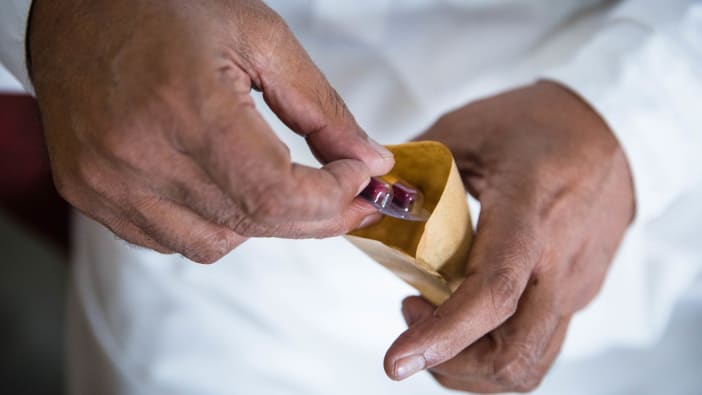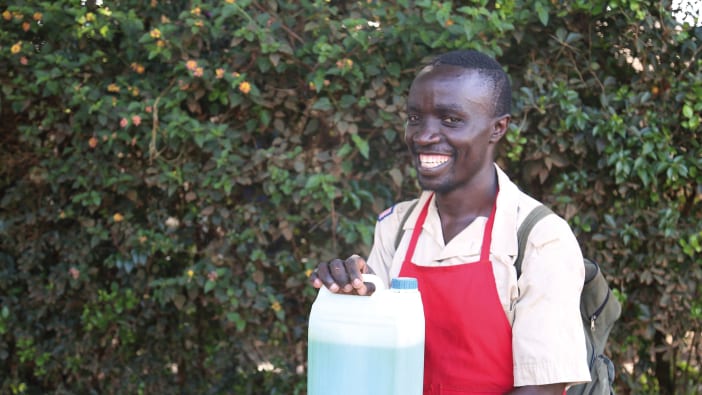by Dr Hans-Martin Hirt and Dr Keith Lindsey.
When Europeans first arrived in Africa, Asia and the Americas and witnessed practices such as ritual sacrifice and ancestor worship, they quickly labelled these as primitive. Instead, they introduced the people to European customs, culture and religion. However, we now recognise that there is much to learn from these traditional cultures. In rejecting some dangerous practices, many other beneficial practices were ignored.
A desperate situation
Today, western chemical and pharmaceutical firms are rushing to patent the production of medicines from tropical plants such as the neem and shea butter trees, periwinkle and many other plants. The healing properties of many of these plants is now proven by recent scientific research, but they have been used in traditional recipes for many centuries.
The situation in many tropical countries is now quite desperate. The rising price of medical drugs, modern patenting laws and the fall in value of local currencies mean that medical centres sometimes cannot afford even the most basic drugs. At the same time, local knowledge and skills about herbal remedies are being rapidly lost. Many communities are being left with no health expertise at all.
Co-operation between all concerned in providing healthcare – both traditional healers and medical staff – is therefore extremely important for the well-being of local people.
Getting together
Anamed is a small, Christian initiative in Germany. They have considerable experience in providing seminars on ‘natural medicine’. These seminars usually last for one week with about 30 people, some of whom are trained in modern medical practice such as doctors, nurses and primary healthcare workers, and some of whom are traditional healers.
Anamed describes natural medicine as combining the advantages of the medicine of the South with those of the medicine of the North.
Good, traditional herbal medicine is accessible, uses locally available plants, is relatively cheap (and can sometimes be paid for in chickens instead of money) and is very personal. Modern medicine, on the other hand, emphasises the importance of cleanliness and hygiene, and accurate measurement and dosages. So each party has a lot to learn from the other!
Today there is still often deep suspicion and mistrust between traditional healers and hospital workers. We understand both parties. From the point of view of doctors and missionaries, healers instil fear, put curses on people, do ridiculous things like ‘removing false teeth’, or cause terrible mutilations, thereby often killing people. From the view of the healer, on the other hand, doctors exploit their patients, have no understanding of cultural beliefs and behaviour and do not reveal their knowledge about how to prevent diseases. Many healers believe that doctors do not try to bring good health to the region, but rather seek to make lots of money by treating a high number of ‘their’ former patients.
Mutual respect
During the seminars, an important first step is arranging for the healers and doctors to eat the same meals together, and to sleep in the same houses! The second step is to enable mutual respect to develop by allowing them to recognise that each has successes and failures in their treatments. The third step is then to begin sharing some of their knowledge with each other.
On the last day of our seminars, we discuss how to organise future cooperation. The medical workers elect one person to be their representative, and the healers do the same. These two representatives meet every month, or more often when problems arise. They act as the formal channel of communication between the groups. Here are examples of situations that may well arise:
- On the morning round, the doctor discovers a cancer patient has been given deep, bleeding and infected cuts during the night by a healer who stole into the hospital! As a result, the doctor calls the medical representative, who speaks with the representative of the healers. In this way, any repetition of this problem is avoided.
- A diabetic patient is unable to buy insulin and seeks help in the hospital. Working through their representatives, a healer known for his success in treating diabetes is found. The hospital offers its laboratory facilities for this healer to examine, free of charge, the success or failure of his herbal treatment!
Many churches accuse the healers of practising witchcraft. In our seminars we always take enough time to discuss this very important issue. It is, however, certainly the case that if a healer has ready access to all the plants he needs, the temptation to use witchcraft will be much less. Establishing a medicinal garden to provide a constant supply of herbs is vital.
The benefits of the seminars
We find that bringing together traditional and medical healers has the following positive results…
The general population is better informed, as local health committees choose representatives to attend the seminars, who report back to the people. People are better protected from bad and dangerous practices. For example, one source of HIV/AIDS and hepatitis B infection in DR Congo is from some 40,000 untrained healers who give injections using unsterilised syringes. Trained healers and traditional midwives can provide better treatment without spreading HIV/AIDS.
- Medical staff learn the value and effects of medicinal plants, and begin to use them for treatment.
- Traditional healers learn how to use accurate doses, to preserve their products better, and the importance of hygiene.
- Traditional midwives are no longer forced to practise illegally but, after training, provide better maternity and baby care.
- The environment is improved as indigenous plants that are used medicinally gain economic value, and will therefore be protected.
Encouraging good practice
We encourage ‘traditional healers’ to practise natural medicine. This means they agree NEVER to:
- give injections
- make tattoos
- practise cuttings (in the hope of releasing the pain or bad spirits)
- remove so-called ‘false teeth’ from children (The new teeth of young children who suffer malnutrition shine through the gum. Some believe the ‘old’ tooth must be removed.)
- practise any form of surgery
- use any form of witchcraft
- carry out abortions
- use excrement
- give enemas.
Instead, we encourage them to:
- provide preventive care for their community
- educate people in preventive healthcare
- use medicinal teas
- use safe recipes to produce medicines like ointments and oils
- establish a garden of medicinal and nutritious plants
- specialise in treating one disease.
Advantages of the two systems - Western (modern) medicine and Traditional, herbal medicine
|
Western (modern) |
Traditional, (herbal) |
|
Hygienic |
It uses locally available plants |
|
Scientific and internationally accepted |
There is no dangerous waste requiring safe disposal |
|
The medical practitioner has a lot of training and understands the body and disease |
No problems of foreign exchange for expensive drugs or delays at customs |
|
A full medical examination is given, with laboratory tests |
Usually cheap for the patient |
|
Uses accurate dosages |
Creates employment in the medicinal garden and the preparation of medicines |
|
Medicines last a long time |
Money paid for treatment stays in the local economy |
|
Plants are identified by their scientific names |
Encourages self reliance |
|
The government controls standards of medical practice |
The healer speaks the same language as the people |
|
A large number of patients can be treated, for example during epidemics |
Sometimes the only medical help available |
Medical workers can increase the scope of their work significantly by establishing a medicinal garden and preparing and using medicines from the plants.
Here in Anamed, we are convinced that natural medicine combines the advantages of both systems. In countries which value the use of traditional herbs, the Ministry of Health can achieve far more, even on a limited health budget.
Dr Hans-Martin Hirt has many years’ experience in rural DR Congo. He and Keith Lindsey have a commitment to empowering and enabling people in their local communities through the exchange of knowledge. Anamed invite readers of Footsteps to do the same.
Contact: Anamed, Schafweide 77, 71364 Winnenden, Germany. Fax: +49 7195 65367 Email: [email protected] Website: www.anamed.org
Please note that Anamed are unable to either identify or carry out scientific analysis on medicinal plants for Footsteps readers. They are also unable to provide free literature or funding.









